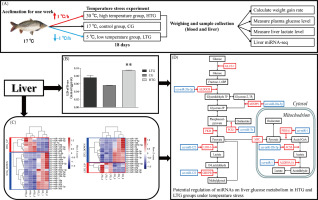当前位置:
X-MOL 学术
›
Comp. Biochem. Physiol. D Genom. Proteom.
›
论文详情
Our official English website, www.x-mol.net, welcomes your feedback! (Note: you will need to create a separate account there.)
Potential regulation by miRNAs on glucose metabolism in liver of common carp (Cyprinus carpio) at different temperatures.
Comparative Biochemistry and Physiology D: Genomics & Proteomics ( IF 3 ) Pub Date : 2019-10-19 , DOI: 10.1016/j.cbd.2019.100628 JunLong Sun 1 , Qiao Liu 1 , LiuLan Zhao 1 , Can Cui 1 , Hao Wu 1 , Lei Liao 1 , Gang Tang 1 , ShiYong Yang 1 , Song Yang 1
Comparative Biochemistry and Physiology D: Genomics & Proteomics ( IF 3 ) Pub Date : 2019-10-19 , DOI: 10.1016/j.cbd.2019.100628 JunLong Sun 1 , Qiao Liu 1 , LiuLan Zhao 1 , Can Cui 1 , Hao Wu 1 , Lei Liao 1 , Gang Tang 1 , ShiYong Yang 1 , Song Yang 1
Affiliation

|
Water temperature can affect the metabolism of fish. Common carp (Cyprinus carpio) is a representative eurythermic fish that can survive at a wide range of ambient temperatures, allowing it to live in an extensive geographical range. The goal of this work was to study the glucose metabolism of common carp at different temperatures and determine the miRNAs involved in the regulation of glucose metabolism. We determined the indicators related to glucose metabolism after long-term temperature stress and constructed nine small RNA libraries of livers under different temperature stress (5 °C, 17 °C, and 30 °C, with three biological replicates for each temperature), and subjected these samples to high-throughput sequencing. A positive relationship was observed between weight gain rate (WGR) and temperature increase after 18 days of temperature stress. However, the glucose level in the plasma maintained a gentle decrease. Unexpectedly, liver lactic acid levels were elevated in HTG (high temperature group) and LTG (low temperature group). Six down-regulated miRNAs (miR-122, miR-30b, miR-15b-5p, miR-20a-5p, miR-1, and miR-7b) were identified as involved in the regulation of glycolysis. Twelve genes were predicted as targets of these miRNAs, and these genes are in pathways related to pyruvate metabolism, glycolysis/gluconeogenesis, and the citrate cycle (TCA cycle). The results allowed prediction of a potential regulatory network of miRNAs involved in the regulation of glycolysis. The target genes of six down-regulated miRNAs were up-regulated under temperature stress, including Aldolase C, fructose-bisphosphate, b (ALDOCB), multiple inositol-polyphosphate phosphatase 1 (MINPP1), phosphoenolpyruvate carboxykinase 1 (PCK1), pyruvate dehydrogenase E1 alpha 1 (PDHA1), aldehyde dehydrogenase 9 family member A1a (ALDH9A1A), Acetyl-coenzyme A synthetase (ACSS), lactate dehydrogenase b (LDH-b), and glyoxylate reductase/hydroxypyruvate reductase (GRHPR). Other key genes of glycolysis, glucose transporter 1 (GLUT-1), pyruvate kinase PKM (PKM), and mitochondrial pyruvate carrier (MPC) were significantly up-regulated in LTG and HTG. Overall, the results suggest that miRNAs maintain their energy requirements by regulating glycolysis and play an important role in the molecular response to cold and heat stress of common carp. These data provide the foundation for further studies of the role of miRNAs in environmental adaptation in fish.
中文翻译:

在不同温度下,miRNA对鲤鱼肝脏葡萄糖代谢的潜在调节作用。
水温会影响鱼的新陈代谢。鲤鱼(Cyprinus carpio)是一种有代表性的脉热鱼类,可以在很宽的环境温度下生存,从而可以在广泛的地理范围内生活。这项工作的目的是研究不同温度下鲤鱼的葡萄糖代谢,并确定参与葡萄糖代谢调控的miRNA。我们确定了长期温度胁迫后与葡萄糖代谢相关的指标,并构建了9个在不同温度胁迫(5°C,17°C和30°C,每个温度下有3个生物学重复)的肝脏小RNA库,并且对这些样品进行高通量测序。在温度应激18天后,体重增加率(WGR)与温度升高之间存在正相关关系。但是,血浆中的葡萄糖水平保持缓慢下降。出乎意料的是,HTG(高温组)和LTG(低温组)的肝乳酸水平升高。六个下调的miRNA(miR-122,miR-30b,miR-15b-5p,miR-20a-5p,miR-1和miR-7b)被确定参与糖酵解的调控。预计将有十二个基因作为这些miRNA的靶标,并且这些基因处于与丙酮酸代谢,糖酵解/糖异生和柠檬酸盐循环(TCA循环)相关的途径中。结果允许预测参与糖酵解调控的miRNA的潜在调控网络。在温度胁迫下,六个下调的miRNA的靶基因被上调,包括Aldolase C,果糖-双磷酸b(ALDOCB),多种肌醇-聚磷酸磷酸酶1(MINPP1),磷酸烯醇丙酮酸羧激酶1(PCK1),丙酮酸脱氢酶E1α1(PDHA1),醛脱氢酶9家族成员A1a(ALDH9A1A),乙酰辅酶A合成酶(ACSS),乳酸脱氢酶b(LDH-b)和乙醛酸还原酶/ (GRHPR)。糖酵解的其他关键基因,葡萄糖转运蛋白1(GLUT-1),丙酮酸激酶PKM(PKM)和线粒体丙酮酸载体(MPC)在LTG和HTG中显着上调。总体而言,结果表明,miRNA通过调节糖酵解来维持其能量需求,并且在鲤鱼对冷热胁迫的分子反应中起重要作用。这些数据为进一步研究miRNA在鱼类环境适应中的作用提供了基础。醛脱氢酶9家族成员A1a(ALDH9A1A),乙酰辅酶A合成酶(ACSS),乳酸脱氢酶b(LDH-b)和乙醛酸还原酶/羟基丙酮酸还原酶(GRHPR)。糖酵解的其他关键基因,葡萄糖转运蛋白1(GLUT-1),丙酮酸激酶PKM(PKM)和线粒体丙酮酸载体(MPC)在LTG和HTG中显着上调。总体而言,结果表明,miRNA通过调节糖酵解来维持其能量需求,并且在鲤鱼对冷热胁迫的分子反应中起重要作用。这些数据为进一步研究miRNA在鱼类环境适应中的作用提供了基础。醛脱氢酶9家族成员A1a(ALDH9A1A),乙酰辅酶A合成酶(ACSS),乳酸脱氢酶b(LDH-b)和乙醛酸还原酶/羟基丙酮酸还原酶(GRHPR)。糖酵解的其他关键基因,葡萄糖转运蛋白1(GLUT-1),丙酮酸激酶PKM(PKM)和线粒体丙酮酸载体(MPC)在LTG和HTG中显着上调。总体而言,结果表明,miRNA通过调节糖酵解来维持其能量需求,并且在鲤鱼对冷热胁迫的分子反应中起重要作用。这些数据为进一步研究miRNA在鱼类环境适应中的作用提供了基础。葡萄糖转运蛋白1(GLUT-1),丙酮酸激酶PKM(PKM)和线粒体丙酮酸载体(MPC)在LTG和HTG中显着上调。总体而言,结果表明,miRNA通过调节糖酵解来维持其能量需求,并且在鲤鱼对冷热胁迫的分子反应中起重要作用。这些数据为进一步研究miRNA在鱼类环境适应中的作用提供了基础。葡萄糖转运蛋白1(GLUT-1),丙酮酸激酶PKM(PKM)和线粒体丙酮酸载体(MPC)在LTG和HTG中显着上调。总体而言,结果表明,miRNA通过调节糖酵解来维持其能量需求,并且在鲤鱼对冷热胁迫的分子反应中起重要作用。这些数据为进一步研究miRNA在鱼类环境适应中的作用提供了基础。
更新日期:2019-10-19
中文翻译:

在不同温度下,miRNA对鲤鱼肝脏葡萄糖代谢的潜在调节作用。
水温会影响鱼的新陈代谢。鲤鱼(Cyprinus carpio)是一种有代表性的脉热鱼类,可以在很宽的环境温度下生存,从而可以在广泛的地理范围内生活。这项工作的目的是研究不同温度下鲤鱼的葡萄糖代谢,并确定参与葡萄糖代谢调控的miRNA。我们确定了长期温度胁迫后与葡萄糖代谢相关的指标,并构建了9个在不同温度胁迫(5°C,17°C和30°C,每个温度下有3个生物学重复)的肝脏小RNA库,并且对这些样品进行高通量测序。在温度应激18天后,体重增加率(WGR)与温度升高之间存在正相关关系。但是,血浆中的葡萄糖水平保持缓慢下降。出乎意料的是,HTG(高温组)和LTG(低温组)的肝乳酸水平升高。六个下调的miRNA(miR-122,miR-30b,miR-15b-5p,miR-20a-5p,miR-1和miR-7b)被确定参与糖酵解的调控。预计将有十二个基因作为这些miRNA的靶标,并且这些基因处于与丙酮酸代谢,糖酵解/糖异生和柠檬酸盐循环(TCA循环)相关的途径中。结果允许预测参与糖酵解调控的miRNA的潜在调控网络。在温度胁迫下,六个下调的miRNA的靶基因被上调,包括Aldolase C,果糖-双磷酸b(ALDOCB),多种肌醇-聚磷酸磷酸酶1(MINPP1),磷酸烯醇丙酮酸羧激酶1(PCK1),丙酮酸脱氢酶E1α1(PDHA1),醛脱氢酶9家族成员A1a(ALDH9A1A),乙酰辅酶A合成酶(ACSS),乳酸脱氢酶b(LDH-b)和乙醛酸还原酶/ (GRHPR)。糖酵解的其他关键基因,葡萄糖转运蛋白1(GLUT-1),丙酮酸激酶PKM(PKM)和线粒体丙酮酸载体(MPC)在LTG和HTG中显着上调。总体而言,结果表明,miRNA通过调节糖酵解来维持其能量需求,并且在鲤鱼对冷热胁迫的分子反应中起重要作用。这些数据为进一步研究miRNA在鱼类环境适应中的作用提供了基础。醛脱氢酶9家族成员A1a(ALDH9A1A),乙酰辅酶A合成酶(ACSS),乳酸脱氢酶b(LDH-b)和乙醛酸还原酶/羟基丙酮酸还原酶(GRHPR)。糖酵解的其他关键基因,葡萄糖转运蛋白1(GLUT-1),丙酮酸激酶PKM(PKM)和线粒体丙酮酸载体(MPC)在LTG和HTG中显着上调。总体而言,结果表明,miRNA通过调节糖酵解来维持其能量需求,并且在鲤鱼对冷热胁迫的分子反应中起重要作用。这些数据为进一步研究miRNA在鱼类环境适应中的作用提供了基础。醛脱氢酶9家族成员A1a(ALDH9A1A),乙酰辅酶A合成酶(ACSS),乳酸脱氢酶b(LDH-b)和乙醛酸还原酶/羟基丙酮酸还原酶(GRHPR)。糖酵解的其他关键基因,葡萄糖转运蛋白1(GLUT-1),丙酮酸激酶PKM(PKM)和线粒体丙酮酸载体(MPC)在LTG和HTG中显着上调。总体而言,结果表明,miRNA通过调节糖酵解来维持其能量需求,并且在鲤鱼对冷热胁迫的分子反应中起重要作用。这些数据为进一步研究miRNA在鱼类环境适应中的作用提供了基础。葡萄糖转运蛋白1(GLUT-1),丙酮酸激酶PKM(PKM)和线粒体丙酮酸载体(MPC)在LTG和HTG中显着上调。总体而言,结果表明,miRNA通过调节糖酵解来维持其能量需求,并且在鲤鱼对冷热胁迫的分子反应中起重要作用。这些数据为进一步研究miRNA在鱼类环境适应中的作用提供了基础。葡萄糖转运蛋白1(GLUT-1),丙酮酸激酶PKM(PKM)和线粒体丙酮酸载体(MPC)在LTG和HTG中显着上调。总体而言,结果表明,miRNA通过调节糖酵解来维持其能量需求,并且在鲤鱼对冷热胁迫的分子反应中起重要作用。这些数据为进一步研究miRNA在鱼类环境适应中的作用提供了基础。



























 京公网安备 11010802027423号
京公网安备 11010802027423号